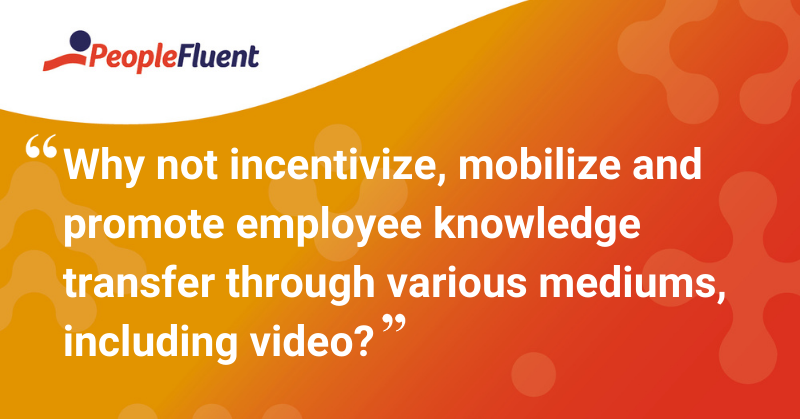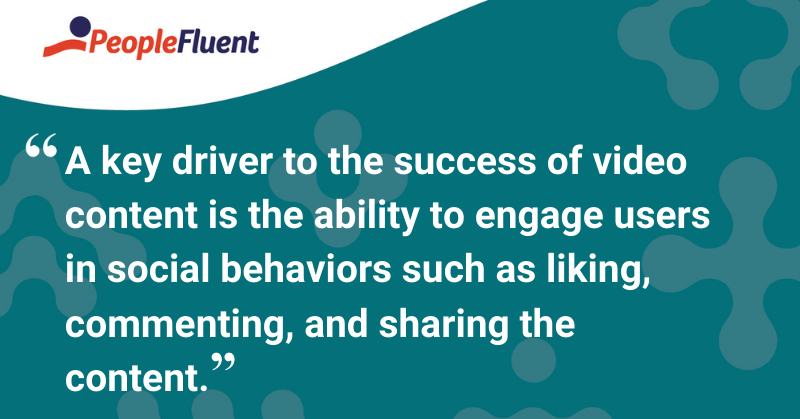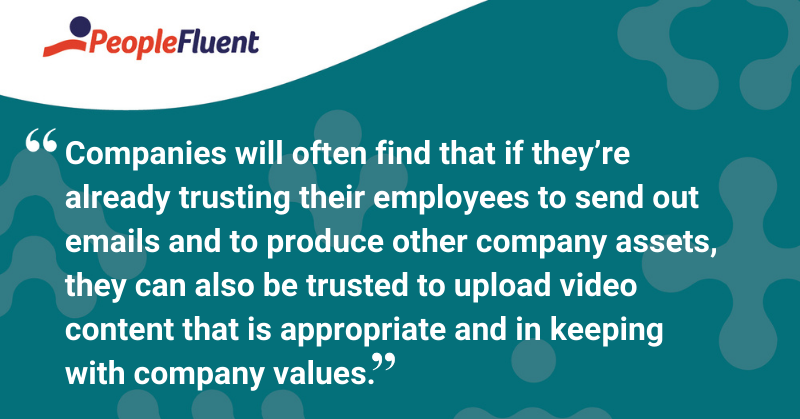Published: Jan 29, 2021Time to read: 9mins Category: Learning
7 Ways of Overcoming Obstacles to User-Generated Video Learning Content
The way organizations view and mobilize user-generated content varies from business to business. Some approach it from a conservative standpoint, uncertain how to loosen the reins, while others celebrate it, taking a ‘more the merrier’ approach. The reality is that mobilizing your workforce to effectively transfer knowledge through a video-centric learning experience platform has numerous benefits and companies should capitalize on this trend. Here, PeopleFluent’s Senior VP, Jeff Fissel, shares seven ways companies can overcome obstacles to employee video content creation.
How user-generated video content is created and shared across organizations is unique to every business. Some companies trust their employees to publish video content and others are averse to promoting it due to legal, regulatory, or compliance reasons. However, the reality is that user-generated content is probably happening whether an organization enables it or not.
At a fundamental level, companies are already providing their workforce with the tools to create content. Email, PDFs, and PowerPoint presentations are just some of the ways we create and share information with each other. At the very best, organizations have a dedicated space for content to be properly housed. And in the worst-case scenarios, employees upload content into a public file share service that the company doesn’t control.
So, if it’s already happening, why not incentivize, mobilize, and promote employee knowledge transfer through various mediums, including video? Let’s unlock the various ways companies can enable user-generated video content within their teams.

RELATED READING | ‘Creator-Centric Video: The New Normal for Corporate Learning?’
Video as an Optimal Tool to Promote User-Generated Content
Video has become one more way—and a powerful one—in which teams and employees can communicate ideas effectively. When considering user-generated content for learning and training, it’s essential to provide a safe and secure place that encourages content creation.
Also, having the appropriate workflows and approvals is more important than not using video at all. In fact, it’s very likely that if a company doesn’t establish appropriate processes for user-generated content, it will inadvertently signal employees that it’s okay to share content in other ways. And these ways could leave them blind as to what exactly is being produced and shared internally.
Video has permeated our lives as a powerful, ubiquitous medium to deliver information. While some employees might not feel comfortable with the idea of recording themselves, others already feel confident in front of a camera and find it’s an easy way to share important information.
Providing employees the ability to share knowledge through video is a step in the right direction in the way that we’re consuming information today. Giving them the tools, process, and backing is the next logical step.
CONTINUE READING | ‘6 Reasons Why You Need to Start Using eLearning Video—Today!’
With employee-generated video content becoming a newer trend within businesses, it’s important to consider how content will be produced, uploaded, approved, and shared among employees. Here are seven ideas on how to overcome organizational obstacles related to employee video production.
1. Provide the Right Technology to Enable Video Content Production
Choosing the right video production tool is essential to the success and adoption of video as a content tool. Some key aspects to consider are:
- Ease of use: Employees will use a video tool if they feel it’s simple to adopt. Although many companies advertise their video production platforms as easy to use, take the technology for a test drive first, to ensure it meets your expectations.
- Storage: Consider how the content can be housed within the platform. Does it provide a way to upload content into deep hierarchies? Will employees be able to easily label and store their content in a way that makes sense? Providing this framework will ensure content is stored correctly and in a safe environment.
- Search functionality: Once the content is uploaded, ensure the search functionally within the platform works well. Simply storing content isn’t enough—you’ll want to be able to easily search and find it, too.
- Social engagement features: A key driver to the success of video content is the ability to engage users in social behaviors such as liking, commenting, and sharing the content. This will promote peer recognition, camaraderie, and productive discussions. Be sure your chosen technology includes these features, as well as metrics to measure how content is performing—this provides clues on the type of content employees are consuming.

RECOMMENDED FOR YOU | ‘Hollywood Hacks: 4 Ideas for Affordable, Professional-Quality Video Learning Content’
2. Offer Advice on Video Broadcast Quality and Content Quality
Not everyone feels super confident when producing video content. However, this doesn’t mean that it can’t be facilitated.
Find an employee or L&D professional within the organization who’s knowledgeable about the topic and ask them to offer advice to their peers through, you guessed it, a video! If background, lighting, and camera set up are important, then communicate that. However, the importance of good audio quality cannot be stressed enough.
Being able to understand the information being presented is perhaps the most important aspect of video. If viewers can’t make out what’s being shared, video content will fall flat. On the content front, shorter is always better and sometimes even more challenging to achieve. When you give your employees ways to talk about their expertise in an effective, succinct way, it helps ensure that just the right amount of information goes out at a given time.
HANDPICKED FOR YOU | ‘Are You Shifting to Self-Directed Learning? Here’s How to Do It Right’
3.Provide Training on How to Effectively Teach Online
Subject matter experts across an organization are as essential today as ever. However, not everyone knows how to impart knowledge effectively. The workaround here is simple: teach how to teach.
Zero in on the talent whose knowledge you’d like to mobilize and offer training on how to properly deliver it—ideally via video. Once they get a sense of it, they will feel more confident and will likely receive positive feedback from peers, leading them to want to share more.

4. Attribute Content to an Individual, Not the Company
Attributing content to the individual and not the company is an important distinction to make here. Yes, an employee may have acquired the information during their role within the company, but recording and uploading the content doesn’t necessarily attribute the content to the company’s overall views and beliefs—save that for top-down learning content you’d typically find in an LMS, like annual compliance or mandatory training.
In this case, the onus is on the subject matter expert and it’s important to emphasize that it doesn’t necessarily represent the company. Simply put, an employee is sharing what they know for the greater good of their teams and the organization, and it shouldn't be viewed as PR.
YOU MIGHT ALSO LIKE | ‘What's the Difference Between an LMS and an LXP? [Buyer's Guide]’
4. Incentivize Good Content Generation for Best Results
Companies should be incentivizing user-generated content in order to promote a culture of employee video creation. If it isn’t something led by leadership and other key people within the company, it’s likely not going to happen organically.
Content creation is not necessarily a natural behavior. In fact, it’s traditionally been something of a niche activity with organizations putting roadblocks in place to limit the number of employees that get to create content.
But content creation shouldn’t have to be for an elite group only. Opening it up has to be an organizational decision and it needs to be led from the top down. Moreover, it’s important for companies to live out their culture. A great practice is to have leadership incentivize the behavior by having them record and share video content with their teams.
5. Have a Communication Strategy in Place to Mobilize Content Creation
Video is still new to many companies. So assuming that if it’s created others will go watch it, won’t work in this case. Communicating content creation is important to drive views. In some cases, having someone at the leadership level share new content updates in a consolidated manner will incentivize employees to consume, share, and like the content.
If you decide to let your employees record themselves, make sure there’s a communication strategy in place to drive viewership. Otherwise, employees could lose interest in creating more content. For example, sending out a weekly video digest through email or in your company newsletter can work wonders.
6. Appoint an Owner or Moderator
Finally, if you’re part of an organization sensitive to information sharing due to compliance or regulatory reasons, having a program owner or moderator can easily solve this issue. Who this person is will vary depending on where in the organization user-generated video content production is occurring. Sometimes it’s within departments, such as Human Resources, and sometimes it’s happening within specific teams.
Either way, having a program owner who’s in charge of collecting video content and vetting the information prior to allowing a larger audience to view it, is a best practice that can ensure information is suitable for distribution. Companies will often find that if they’re already trusting their employees to send out emails and to produce other company assets, they can also be trusted to upload video content that is appropriate and in keeping with company values.

MORE FROM THE BLOG | ‘When Features Aren't What Matters: Choosing the Right Technology for Your Organization’
In Summary
Learning platforms enable user-generated content and companies shouldn’t be afraid to let their employees share information through video. In fact, organizations may find that employees become engaged contributors, stellar communicators, and great at sharing their expertise for the benefit of the organization. Teams and employees want to contribute to the progress of their company. Why not mobilize their efforts and know-how through video creation?